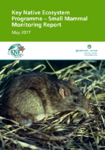Key Native Ecosystem Programme Small Mammal Monitoring Report May 2017
Search in document library
This report presents the results of the small mammal monitoring conducted at Key
Native Ecosystem (KNE) sites in May 2017.
The KNE programme aims to protect some of the best examples of native ecosystem
types in the Wellington region by managing, reducing or removing threats to their
values. Monitoring of pest animals is carried out to establish whether the control efforts
are being effective.
Key results of the small mammal monitoring in May 2017 are summarised below:
The only site to meet its rat tracking target was the Baring Head/?rua-pouanui
KNE site (1 percent tracking vs 10 percent target). The mice tracking rate increased
from 56 to 64 percent.
In the East Harbour Northern Forest KNE site the rat tracking rate approached the
target in the Mainland Island (8 percent tracking vs 5 percent target). Rat tracking
decreased in the Non-treatment area from 66 to 40 percent.
In the Wainuiomata/Orongorongo KNE site the rat tracking rates declined in the
Mainland Island (53 to 38 percent), and showed a slight increase in the Nontreatment
area (83 to 88 percent).
At the Belmont Korokoro KNE site rats tracked at 25 percent and mice at 37
percent.
At the Queen Elizabeth Park KNE site rats tracked at 25 percent while the mice
tracking rate continued to spike wildly, rising from 10 percent in November 2016 to 90 percent in this monitor.
Keywords: KNE, rodent, pest, rat, mice, biodiversity, monitoring
